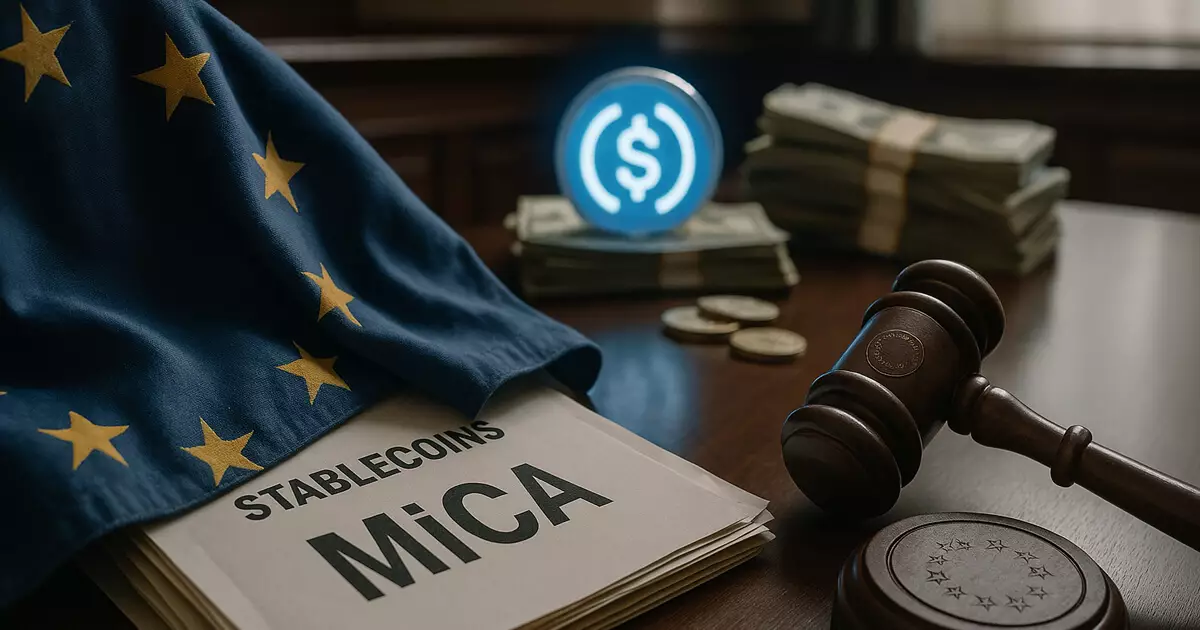The European Union’s Markets in Crypto Assets (MiCA) regulation is painted as a protective measure designed to establish robust frameworks within the volatile world of cryptocurrency. However, beneath the surface, it constitutes a classic case of overreach that inadvertently fortifies the dominance of the U.S. dollar in the global financial arena. While proponents of MiCA may herald it as progress—a necessary step toward safe and responsible crypto engagement—the reality is that it binds European financial innovation, particularly in the realm of euro-denominated stablecoins, effectively narrowing the competitive landscape to the advantage of the dollar.
Stablecoins: The Backbone of Global Transactions
The global financial ecosystem has evolved dramatically; stablecoins serve as essential conduits for quick, borderless transactions, enabling a seamless exchange in an increasingly digitized world. Ironically, despite the EU’s intention to promote the euro, over 99% of the stablecoin market is still pegged to the U.S. dollar. With MiCA’s restrictive measures, the EU is inadvertently solidifying this status quo instead of challenging it. By raising the barriers for euro-backed stablecoins to thrive, the region is not only signaling disinterest in fostering a competitive euro-stablecoin landscape but is also betraying its own ambitions.
A Standoff Against Innovation
MiCA’s regulatory framework sends a chilling message to potential innovators in Europe. By enforcing stringent regulations under the guise of ensuring consumer safety, EU policymakers are essentially stifling the experimentation necessary for euro-stablecoins to flourish. The implication that the EU does not actively want stablecoins, masked by the ambition of pushing forward a Central Bank Digital Currency (CBDC), is a tactic that may backfire severely. Instead of clearing a path for innovation, MiCA erects a regulatory moat that keeps creativity at bay. This opportunistic suppression of private sector innovation stands in stark contrast to the agile, market-driven environment championed by U.S. regulators, allowing them to maintain their edge.
The Weaponization of Regulation
The MiCA regulation’s strictures do not merely impede euro-backed stablecoins; they essentially weaponize regulation against them. The EU’s strategy of fostering a CBDC while dismissing the potential of private stablecoins is not just misguided; it verges on catastrophic. History teaches us that monopolistic state-run projects often fail to reach their full potential because they are unable to adapt like their private-sector counterparts. The U.S. meanwhile appears to have a more mature understanding of innovation—the resilience of the U.S. dollar hinges on stablecoins, which American regulators nurture rather than view with skepticism.
The Geopolitical Blunder
The geopolitical implications of Europe’s decision to prioritize a Euro CBDC over innovative euro-stablecoins are profound. By allowing constraints on euro-stablecoins, MiCA risks escalating the U.S. dollar’s position as the preferred currency, especially as BRICS countries and the EU express a desire to challenge its dominance. Ironically, as the EU attempts to assert the euro’s influence through bureaucratic means, the very fabric of global trade is drifting toward blockchain solutions that favor existing dollar-backed stablecoins. As the dollar takes center stage, Europe could find itself overshadowed—a bystander in the evolution of global finance.
The Path Forward: A Call for Rational Reform
If Europe genuinely aspires to elevate the euro’s global standing, an immediate re-evaluation of its approach is essential. Protectionism does not equal strength; rather, it breeds irrelevance in a fast-evolving market where agility and adaptability are paramount. It’s truly disappointing to witness policymakers prioritize caution over visionary innovation. If there is any hope for the euro to carve out its own niche in the digital realm, it must embrace the concept of innovation with open arms, rather than strangling it in the name of regulation.
Europe risks becoming a footnote in the next chapter of financial innovation—watching from the sidelines as others seize the future. In a world driven by fast-paced technologic change, MiCA might be the catalyst that fortifies the U.S. dollar’s supremacy, rather than positioning Europe as a valuable competitor. Only time will tell if the EU can pivot away from this self-inflicted quagmire, but thus far, the signs are troubling.


Leave a Reply